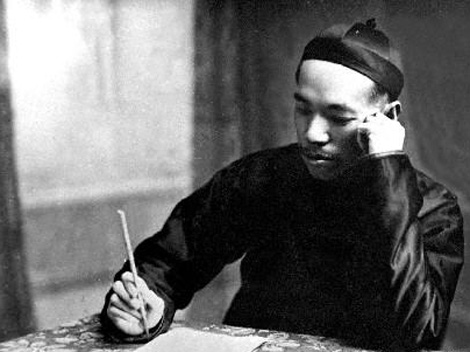Liang Qichao founded the newspaper Shibao in Shanghai in 1904.
Propaganda is central to the operation of the Chinese system of government. Aspects of propaganda—in particular the formalization of imagery and language—can be traced back to the earliest period of Chinese history, but propaganda has been most effective in the twentieth century thanks to the mass media and a powerful authoritarian government.
The earliest surviving texts on governance in China pay great attention to the need for rulers to control and formalize language to secure their authority. Confucius (c. 551– 479 B.C.E.), the most influential philosopher of early China, noted that the “rectification of names” was crucial to the establishment of stable government. The most important source for Confucius’s thoughts are The Analects, a series of dialogues that he is claimed to have held with various disciples, in which he argued for the importance of virtue and moral authority as a means of creating a stable state. Other works believed to have been edited by Confucius, along with the writings of his student, Mencius (c. 371–289 B.C.E.), form part of a canon formalized in the twelfth century. Confucian thought was supplemented by vast numbers of commentaries, which gave rise to various schools of Confucianism. Over the centuries Confucian thought hardened into a doctrine of state governance that stressed the importance of hierarchy; it was made the basis of the examinations qualifying candidates for the state bureaucracy. Confucianism has remained a powerful resource for Chinese rulers even into the present era.
Before the age of mass media, the sharing of religious rituals was one of the most important ways in which state propaganda could be transmitted among the population at large. The state could promote cults of gods based on dead heroes who had served the state, which would then be filtered down to temples at the non-elite level. Even at the elite level, the late imperial period, under the ethnically Manchu Qing dynasty (1644– 1911), saw an increasing use of state propaganda to legitimate the rule of the Manchus in the face of loyalism to the overthrown Ming dynasty. The Kangxi emperor, who ruled from 1661 to 1722, issued a sixteen-point “Sacred Edict” in 1670 that justified his reign in terms of Confucian orthodoxy, thereby successfully challenging Chinese officials to follow that same orthodoxy and serve him. His successor, the Yongzheng emperor, who ruled from 1723 to 1735, expanded on the edict, training scholars in its precepts so that they could go to towns and villages to educate ordinary Chinese citizens about its requirements, thereby ensuring that success in the civil service examinations was based not only on a knowledge of the edicts but also the emperor’s comments on them.
The late nineteenth century saw the Qing dynasty become unstable due to a combination of economic crisis, internal rebellion, and the impact of Western imperialism. During this period Western social and cultural ideas—often transmitted through Japan— were influential among Chinese elites. Among those ideas was that of the public sphere separate from the state, and of associated institutions, such as newspapers. The most politically influential newspaper of the period was Shibao (Times), written by a group of Chinese intellectuals, of whom the most notable was the reformer Liang Qichao (1873–1929). Shibao, published from 1904 to 1939, served as a forum for debates on constitutional reform in China, which influenced the newly emerging urban middle class, particularly in major cities such as Shanghai. Much of the vocabulary of modernity was also popularized through Shibao and other publications by Liang, paving the way for the introduction of ideological thought (nationalism, communism, anarchism, etc.) in the following century.
